Delve into the rich history and cultural significance of ancient Egyptian pottery, ranging from practical vessels to elaborate ceremonial wares. Discover the innovative techniques, materials, and symbolic motifs that showcase Egypt's craftsmanship, spirituality, and artistic legacy.
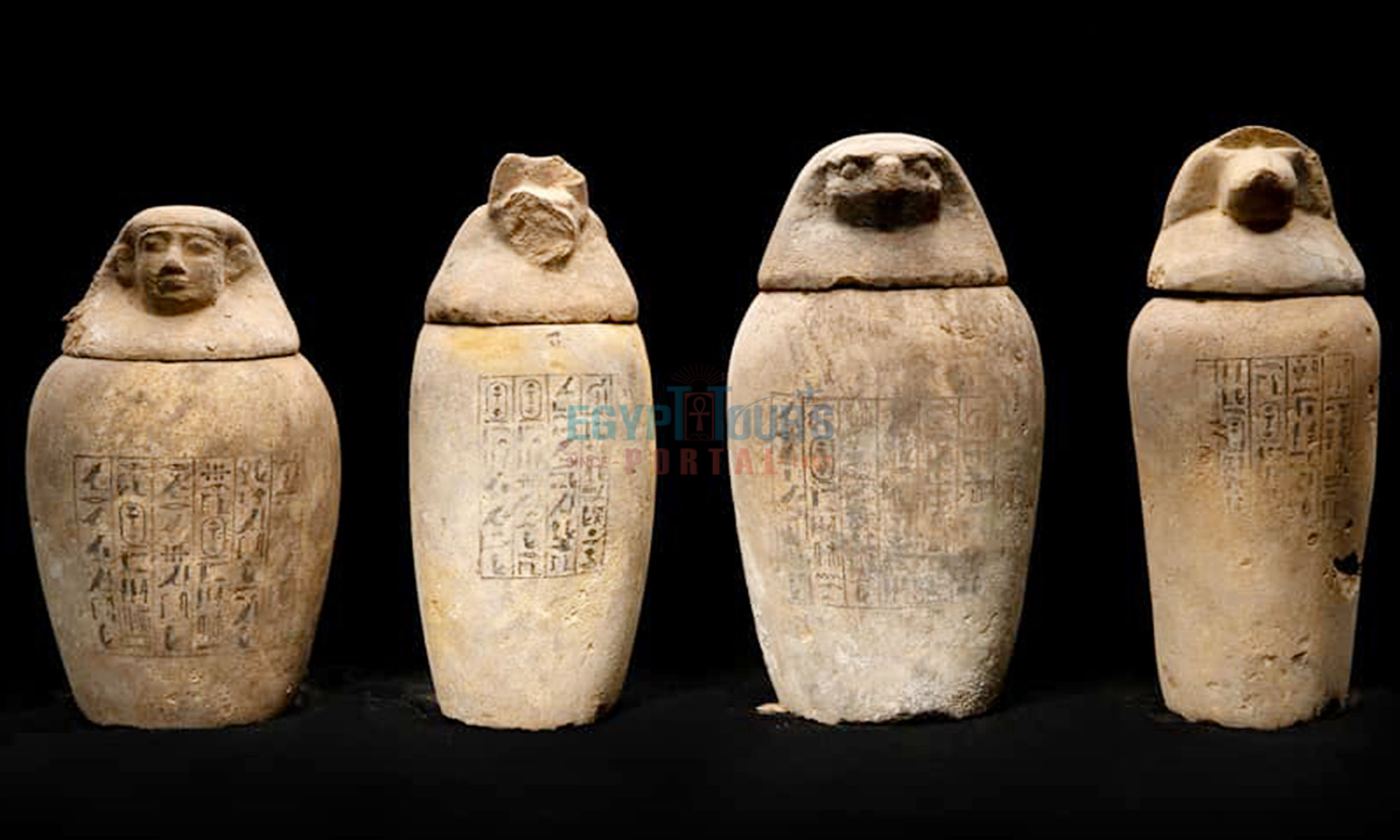
Ancient Egyptian pottery is a cornerstone for understanding the development of Egypt’s technology, art, trade, and daily life. Pottery evolved over 5000 years to reflect both utilitarian needs and spiritual values. Ancient Egyptian artifacts have evolved over the years from simple hand-crafted vessels to elaborately painted ceremonial wares, each piece is a testament to Egypt's ingenuity and its engagement with the surrounding world.
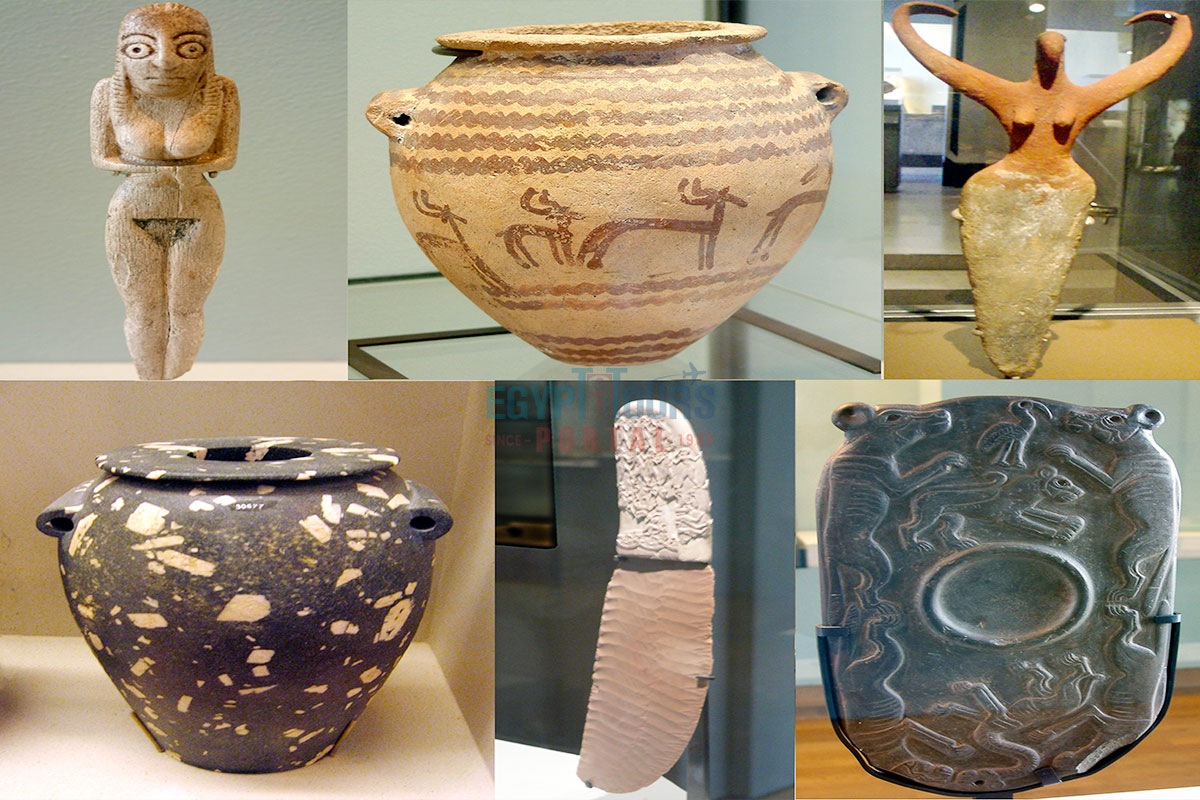
Nile clay, a cornerstone of ancient Egyptian pottery, owes its origins to the fertile deposits left by the Nile River's annual inundations. These sediments, rich in minerals, have accumulated since the Late Pleistocene period, approximately 12,000 years ago.
The clay’s composition, primarily silicon and iron oxides, lends it a reddish-brown hue when fired under oxygen-rich conditions. Its physical properties make it highly workable, allowing potters to shape intricate forms and produce a wide variety of household items with relative ease. The clay’s porous nature was particularly advantageous for making cooling jars such as the zir, which used natural evaporation to chill water.
Early examples of its artistic potential are evident in black-topped red pottery from the Naqada I period (c. 4000–3500 BCE), demonstrating both practical and aesthetic applications of Nile clay. This material was ubiquitous, catering to the daily needs of the ancient Egyptian household while serving as a canvas for artistic innovation.
Marl clay, derived from desert limestone regions such as Qena in Upper Egypt, played a complementary role to Nile clay in ancient pottery production. Unlike the more malleable Nile clay, marl clay is denser and richer in calcium carbonate, which provides greater durability and heat resistance. These properties made marl clay ideal for crafting fine wares and luxury items, including amphorae used for storing oils and wines.
The natural efflorescent salts present in marl clay often create a glaze-like effect during firing, adding a distinctive finish to the vessels. Archaeological discoveries of marl clay amphorae in tombs from the New Kingdom Of Ancient Egypt (c. 1550–1070 BCE) highlight its significance in long-distance trade, as these vessels transported valuable goods across the Mediterranean.
Potters sometimes mixed marl clay with Nile clay to produce hybrid pottery, combining the strength of marl clay with the workability of Nile clay. This innovation reflects the adaptability and ingenuity of ancient Egyptian artisans.
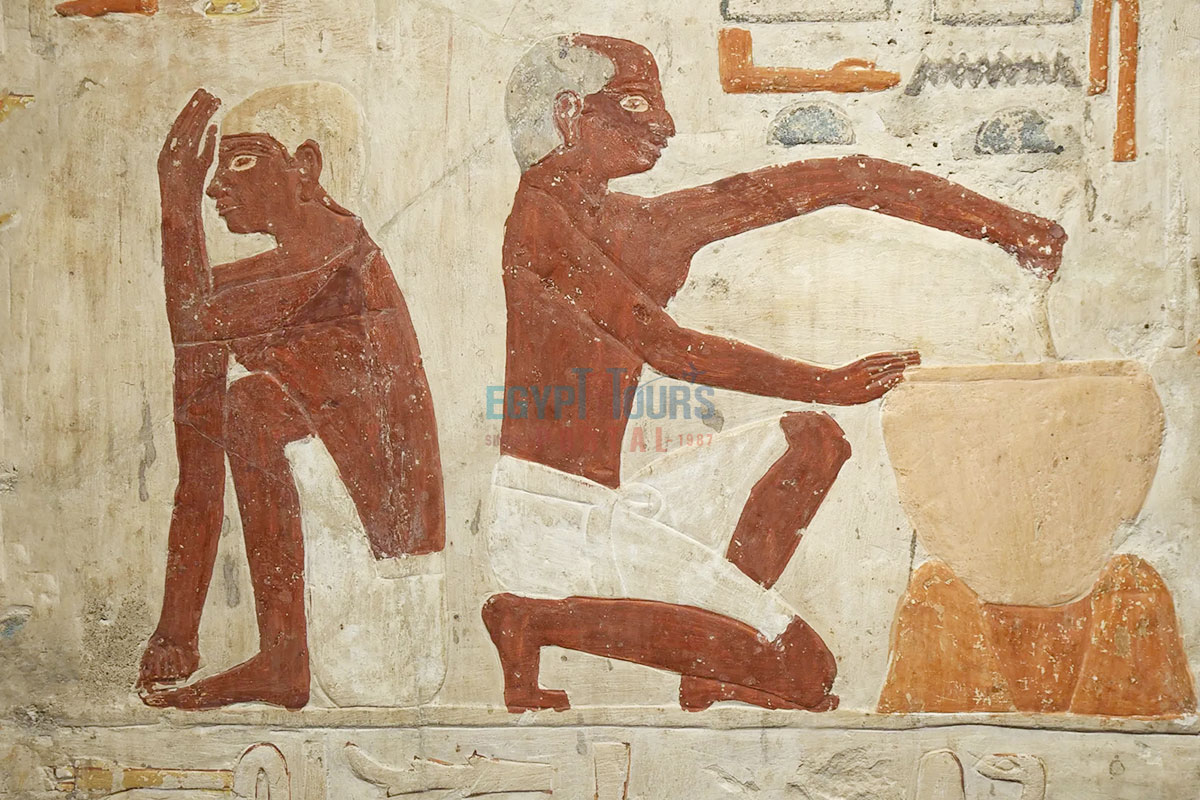
The preparation of clay was a meticulous process that began with sourcing raw materials from the banks of the Nile, irrigation canals, or desert edges. Once collected, the clay underwent refining processes to enhance its quality. Impurities such as stones and organic debris were removed by drying, crushing, and sieving the raw clay.
For finer pottery, an elutriation process was employed, in which clay particles were suspended in water, allowing the finest sediments to be skimmed off for use. To improve durability and prevent cracking during firing, tempering agents like sand, straw, or crushed pottery fragments were added. These additives also enhanced the clay’s thermal properties, making it suitable for a variety of uses. The preparation phase was vital for ensuring the clay’s workability and the longevity of the finished product.
Ancient Egyptian potters employed diverse shaping techniques, ranging from hand modeling to the use of the potter’s wheel. Hand modeling was prevalent during the Predynastic Period (c. 4000–3100 BCE) and included methods such as coiling, where rolls of clay were stacked to form the vessel’s walls, and weaving, which involved interlocking flat strips of clay to create large basins.
The introduction of the slow potter’s wheel during the Old Kingdom Of Ancient Egypt (c. 2686–2181 BCE) marked a significant technological advancement, enabling more symmetrical shapes. By the New Kingdom (c. 1550 BCE), the fast potter’s wheel revolutionized pottery production, allowing artisans to craft vessels with greater speed and precision. Molding techniques also became common during the Middle Kingdom Of Ancient Egypt (c. 2055–1650 BCE), particularly for standardized items like bread pans.
The surface of pottery was often treated to enhance its aesthetic appeal and functionality. Polishing and burnishing were used to achieve finishes ranging from matte to glossy. Incised patterns and impressed designs were added to damp clay, creating geometric motifs or symbolic decorations. Painting was another popular method, with pigments like red ochre and black hematite applied before or after firing.
The use of slip coatings not only smoothed the surface but also added a uniform color, further elevating the pottery’s visual appeal. These surface treatments reflect the balance between utility and artistry in Egyptian ceramics.
The firing process transformed soft clay into durable ceramics through heat. Early potters relied on open pits, where vessels were placed directly in contact with flames and fuel, resulting in uneven heating. The advent of kilns during the Early Dynastic Period (c. 3100 BCE) allowed for better temperature control, enabling potters to fire ceramics at temperatures up to 1000°C.
Kilns also provided a controlled atmosphere, allowing potters to achieve specific effects such as the reddish-brown hue of oxidized clay or the darkened rim of black-topped pottery created under reduced oxygen conditions.
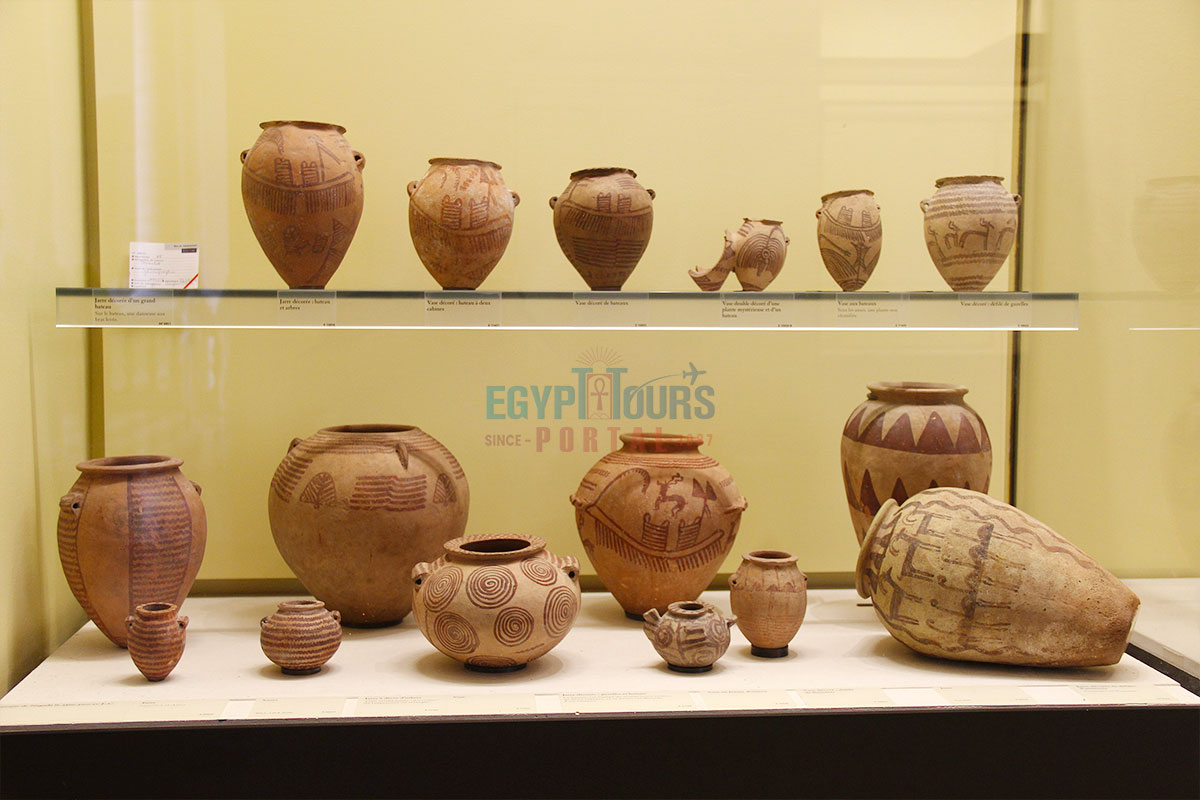
Pottery was integral to daily life in ancient Egypt, serving as vessels for storage, cooking, and lighting. Large jars were used to store grains, oils, and liquids, while amphorae with pointed bases provided stable storage when embedded in the ground.
Bread molds were essential in communal baking, and rounded pots were ideal for stews, reflecting the culinary practices of the time. Simple oil lamps, made from Nile clay, illuminated homes and temples, becoming widespread in the Middle Kingdom.
In religious and funerary contexts, pottery assumed symbolic and practical roles. Ritual vessels held offerings of wine, oils, and food during temple ceremonies, while ceramics adorned with blue-painted motifs symbolized renewal and rebirth.
Burial goods often included pottery to provide sustenance for the deceased in the afterlife of ancient Egypt, as seen in the Tomb of Tutankhamun, where 26 inscribed wine jars detailed the vintages and regions of production. Canopic jars, used in mummification, stored internal organs and were intricately decorated with protective deities.
Explore glorious details about the beliefs and idols of the religion of the ancient Egyptians.
Read More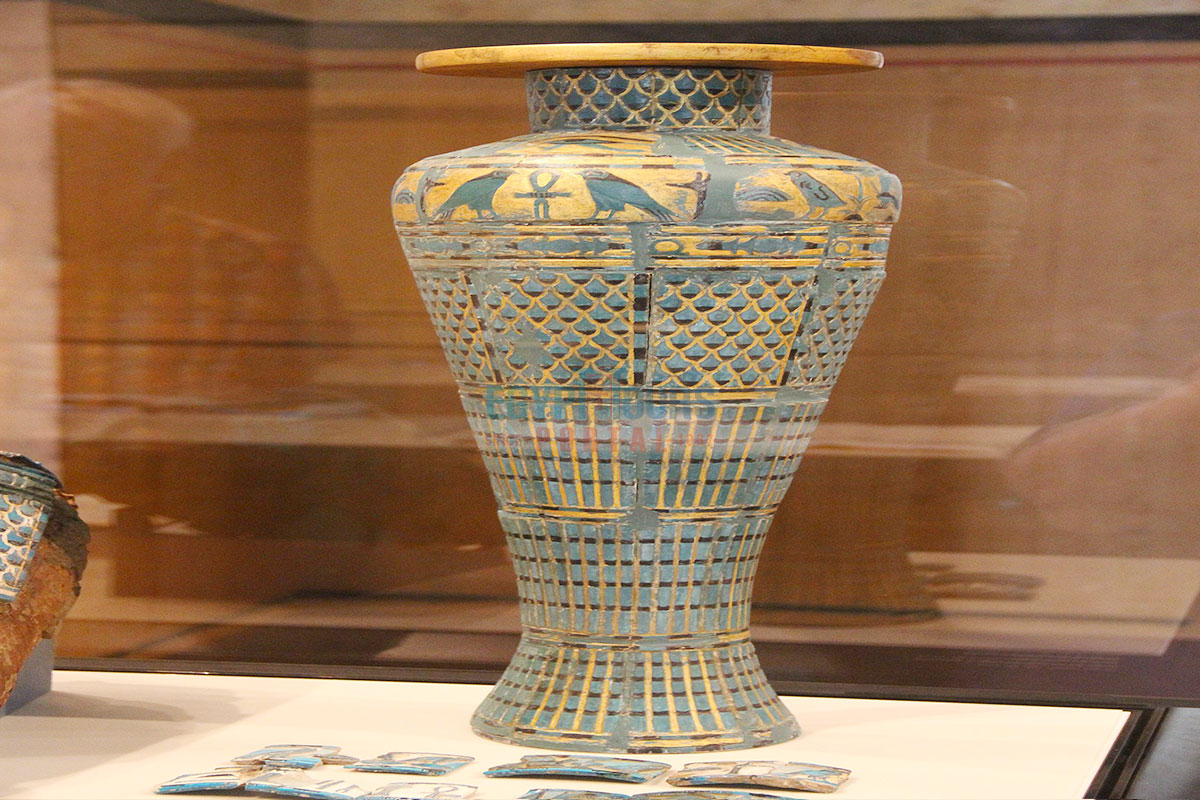
Pottery decoration was rich with Ancient Egyptian symbols and motifs that reflected ancient Egyptian beliefs and aesthetics. Geometric patterns symbolized cosmic order, while depictions of animals, such as cattle and birds, conveyed prosperity and divine connection. Religious symbols, including the lotus (rebirth) and the Eye of Horus (protection), adorned many vessels, reinforcing spiritual significance.
Potters achieved distinct effects through innovative firing and glazing methods. Black-topped pottery, a hallmark of Naqada I culture, resulted from a unique firing process that restricted oxygen at the rim, creating a striking blackened finish.
Natural minerals in marl clay often formed a glossy, glaze-like surface during high-temperature firing, resembling modern glazing techniques. These decorative innovations highlight the technical skill and creativity of Egyptian potters.
Explore exquisite details about the artistic skill and imagination of the ancient Egyptians.
Read More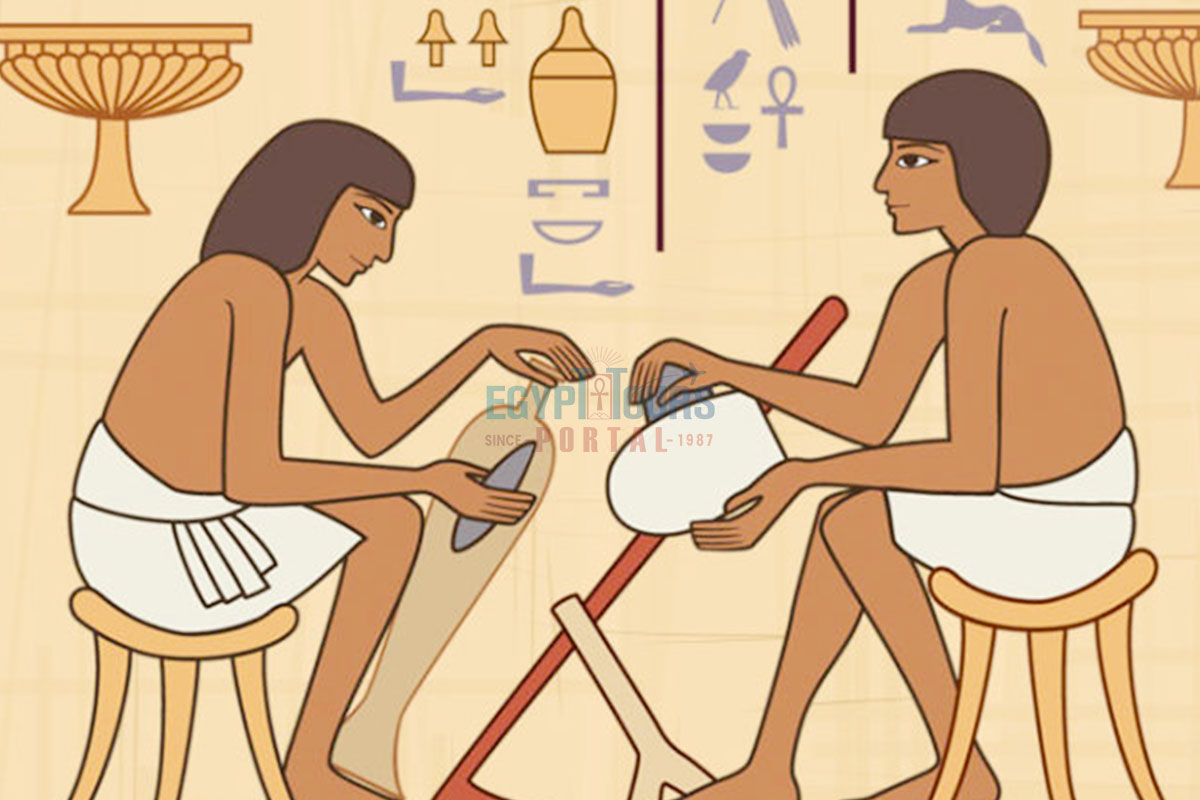
Pottery production was a community effort, often taking place in small workshops or open-air facilities. Depictions in Old Kingdom tombs frequently show pottery-making alongside food production, underscoring its integration into daily life. Workshops like those at Ayn Asil (c. 2300 BCE) were staffed by small teams of artisans who specialized in various stages of production, from clay preparation to firing.
Egyptian pottery played a crucial role in trade, with amphorae and other vessels exported to regions as far as Canaan, Crete, and Mesopotamia. Inscriptions on vessels recorded their contents, origins, and purposes, providing valuable insights into ancient trade practices. The presence of Egyptian pottery in distant lands attests to its importance in the exchange of goods and culture.
Learn about the exquisite details of the economy of the Ancient Egyptian Civilization.
Read More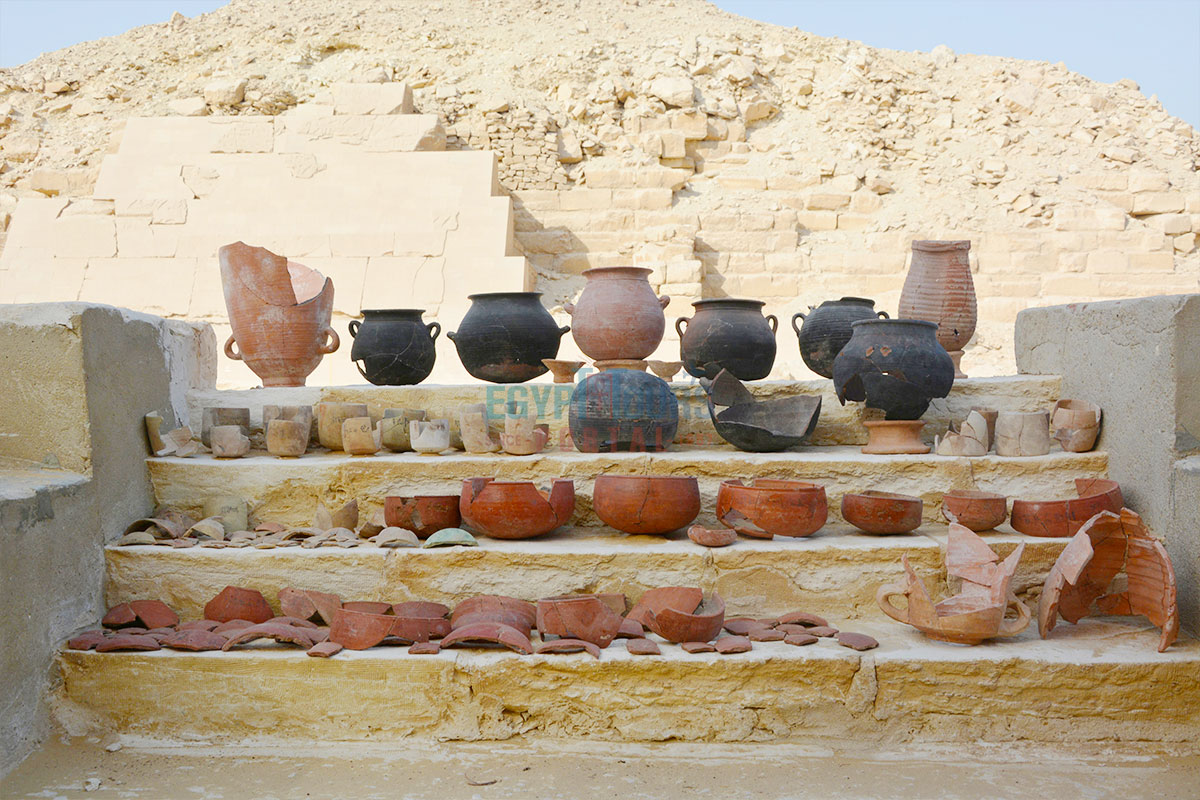
Pottery is a vital tool for archaeologists in reconstructing ancient timelines. Flinders Petrie’s sequence dating method, introduced in 1899, categorized Naqada pottery into three distinct phases, providing a relative chronology of early Egyptian culture. Changes in pottery styles, such as the evolution of bread molds during the First Intermediate Period, reflect broader social and political transitions.
Significant discoveries, such as the inscribed wine jars in Tutankhamun’s tomb, have shed light on the economic and cultural priorities of the New Kingdom. Excavations at Amarna revealed large-scale production of blue-painted pottery, emphasizing its ceremonial and economic significance.
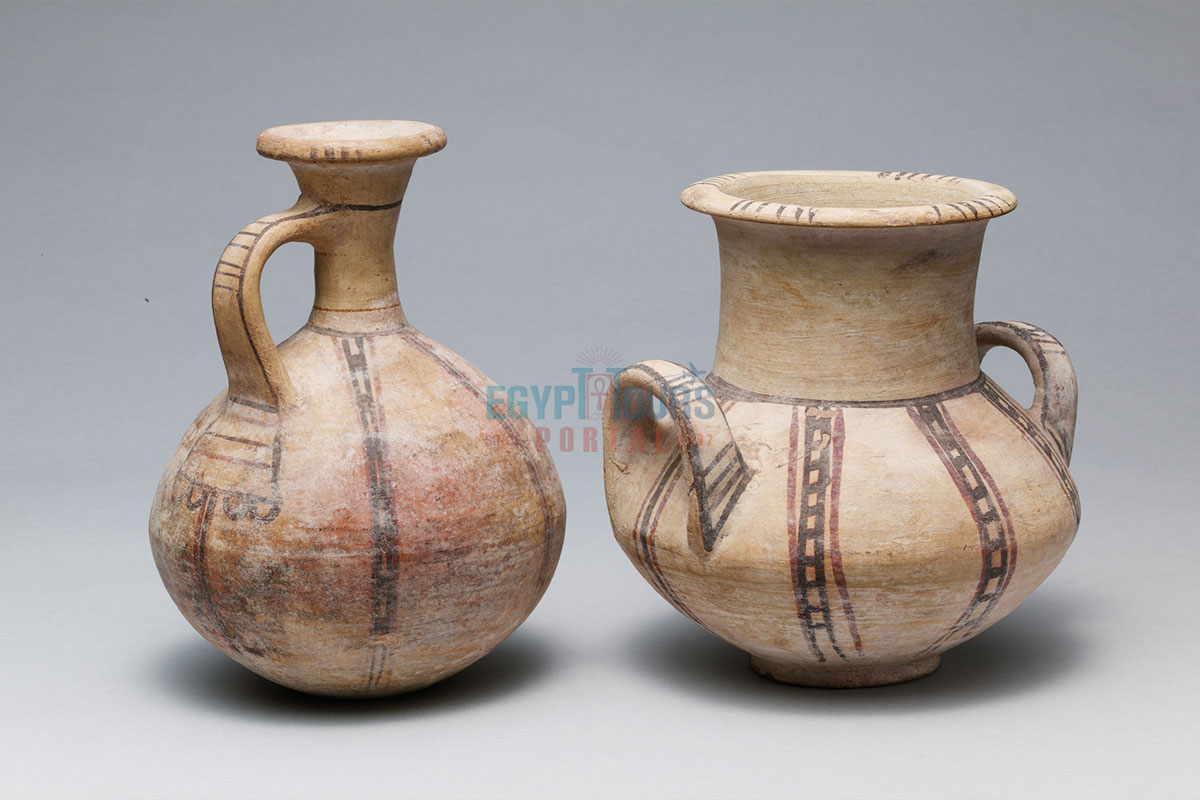
The controlled firing of pottery allowed artisans to produce vessels with consistent colors and textures, meeting the demands of both utilitarian and decorative purposes. Standardization facilitated mass production, ensuring a steady supply of ceramics for a growing population.
Pottery was not only functional but also a symbol of Egypt’s relationship with its environment and spiritual beliefs. The depiction of Khnum, the potter god, crafting life on a potter’s wheel, highlights the divine association of pottery with creation and creativity. This cultural reverence underscores the enduring significance of ceramics in ancient Egyptian society.
Ancient Egyptian pottery is a multifaceted legacy of practicality, artistry, and cultural depth. From the Naqada I period’s black-topped vessels (c. 4000 BCE) to the ceremonial blue-painted pottery of the New Kingdom (c. 1500 BCE), these artifacts offer a detailed narrative of Egypt’s history.
The technological innovations, trade networks, and decorative styles seen in their pottery reflect a civilization at the pinnacle of ingenuity and cultural expression. The beauty of ancient Egyptian culture knows no bounds, offering everyone the chance to discover its radiant art and wonders with our dazzling Egypt tour packages and Egypt Nile cruises.
Private 4 Days Cairo Tour Packages 4 days Cairo Egypt tour package will offer a bles...
Tour Location: Cairo – Giza...
Stunning 5 Days Cairo and Alexandria Tour Package 5 days Cairo and Alexandria tour p...
Tour Location: Cairo/Giza/Alexandria...
Exceptional 6 Days Cairo, Luxor & Aswan Tour Package 6 days Cairo, Luxor & A...
Tour Location: Cairo/Giza/Aswan/Luxor...
Amazing 7 Days Cairo and Hurghada Holiday 7 Days Cairo & Hurghada holiday will e...
Tour Location: Cairo – Giza – Hurgh...
Ancient Egyptian pottery was primarily made from Nile clay, rich in iron, and marl clay, which is finer and less porous, sourced from limestone regions.
Pottery Served Various Purposes, Including Storing Food and Water, Cooking, Brewing Beer, Holding Offerings, and Grave Goods in Burials.
Early Pottery Was Hand-shaped, but Later the Potter's Wheel Was Introduced for Faster Production. Clay Was Shaped, Dried, and Then Fired in Kilns.
Common Types Included Jars, Bowls, Bread Molds, Water Jugs, Oil Lamps, and Decorative Vessels. Funerary Urns and Offering Trays Were Also Significant.
Pottery Was Decorated With Slips, Incised Patterns, Painted Motifs, and Occasionally Glazes. Designs Included Geometric Patterns, Animals, and Religious Symbols.
Pottery Was Naturally Red or Brown Due to the Iron Content in Nile Clay. Black-topped Pottery Was Achieved by Firing Vessels in an Oxygen-restricted Environment.
Black-topped Pottery, a Hallmark of the Predynastic Period, Was an Early Innovation That Highlighted the Artisans' Technical Skills and Aesthetic Preferences.
Pottery Was Used to Hold Offerings for the Gods and the Dead. Funerary Ceramics Included Vessels for Food and Drink, Symbolizing Provisions for the Afterlife.
Pottery Helps Archaeologists Date Sites and Understand Trade, Daily Life, and Technological Advancements. Variations in Pottery Styles Provide Chronological Markers.
Yes, Workshops Were Organized With Artisans and Apprentices Specializing in Different Stages of Pottery Production. Some Were State-run for Large-scale Production.
Imported Pottery From Neighboring Regions Like the Levant and Nubia Influenced Egyptian Styles, While Egyptian Ceramics Were Also Exported.
Finds Like the Large Ceramic Jars at Amarna and Elaborately Painted Vessels From Tutankhamun's Tomb Provide Insights Into the Civilization's Artistry and Daily Life.
Innovations included the Potter's Wheel, Improved Kilns for Controlled Firing, and the Introduction of Glazing Techniques.
The Dry Desert Climate of Egypt Has Preserved Many Pottery Pieces, Making It One of the Most Enduring Artifacts From the Ancient World.
Egyptian Pottery Was Distinctive for Its Functional Simplicity and Symbolic Decoration While Neighboring Cultures Often Adopted and Adapted Egyptian Techniques and Styles.
The entire country of Egypt deserve to be explored with its every heavenly detail but there are places that must be seen before any other such as the breathtaking Hurghada's red sea, The wonders of Cairo the pyramids of Giza, the great sphinx, the Egyptian Museum, Khan El Khalili Bazaar, the wonders of Luxor like Valley of the Kings, Karnak & Hatshepsut temple and the wonders of Aswan such as Abu Simbel temples, Philea temple, Unfinished obelisk and The Wonders of Alexandria like Qaitbat Citadel, Pompey's Pillar and Alexandria Library. Read more about the best places to visit in Egypt.
If you want to apply for a Visa On Arrival that lasts for 30 days then you should be one of the eligible countries, have a valid passport with at least 6 months remaining and pay 25$ USD in cash, as for the E-Visa for 30 day you should have a valid passport for at least 8 months, complete the online application, pay the e-visa fee then print the e-visa to later be presented to the airport border guard. You could also be one of the lucky ones who can obtain a free visa for 90 days. Read more about Egypt travel visa.
Egypt has a variety of delicious cuisines but we recommend “Ful & Ta’meya (Fava Beans and Falafel)”, Mulukhiya, “Koshary”, a traditional Egyptian pasta dish, and Kebab & Kofta, the Egyptian traditional meat dish.
The best time to travel to Egypt is during the winter from September to April as the climate becomes a little tropical accompanied by a magical atmosphere of warm weather with a winter breeze. You will be notified in the week of your trip if the Climate is unsafe and if any changes have been made.
You should pack everything you could ever need in a small bag so you could move easily between your destinations.
We have been creating the finest vacations for more than 20 years around the most majestic destinations in Egypt. Our staff consists of the best operators, guides and drivers who dedicate all of their time & effort to make you have the perfect vacation. All of our tours are customized by Travel, Financial & Time consultants to fit your every possible need during your vacation. It doesn't go without saying that your safety and comfort are our main priority and all of our resources will be directed to provide the finest atmosphere until you return home.
You will feel safe in Egypt as the current atmosphere of the country is quite peaceful after the government took powerful measures like restructuring the entire tourist police to include all the important and tourist attractions in Egypt. Read more about is it safe to travel to Egypt.
Wear whatever feels right and comfortable. It is advised to wear something light and comfortable footwear like a closed-toe shoe to sustain the terrain of Egypt. Put on sun block during your time in Egypt in the summer to protect yourself from the sun.
The best activity is by far boarding a Nile Cruise between Luxor and Aswan or Vise Versa. Witness the beauty of Egypt from a hot balloon or a plane and try all the delicious Egyptian cuisines and drinks plus shopping in old Cairo. Explore the allure and wonders of the red sea in the magical city resorts of Egypt like Hurghada and many more by diving and snorkeling in the marine life or Hurghada. Behold the mesmerizing western desert by a safari trip under the heavenly Egyptian skies.
There are a lot of public holidays in Egypt too many to count either religious or nation, the most important festivals are the holy month of Ramadan which ends with Eid Al Fitr, Christmas and new years eve. Read more about festivals & publich holidays in Egypt.
Egypt is considered to be one of the most liberal Islamic countries but it has become a little bit conservative in the last couple of decades so it is advised to avoid showing your chest, shoulders or legs below the knees.
Arabic is the official language and Most Egyptians, who live in the cities, speak or understand English or at least some English words or phrases. Fewer Egyptians can speak French, Italian, Spanish, and German. Professional tour guides, who work in the tourism sector, are equipped to handle visitors who cannot speak Arabic and they will speak enough English and other languages to fulfill the needs of all our clients.
The fastest way is a car, of course, a taxi. If you are in Cairo ride a white taxi to move faster or you could board the fastest way of transportation in Egypt metro if the roads are in rush hour.
The temperature in Egypt ranges from 37c to 14 c. Summer in Egypt is somehow hot but sometimes it becomes cold at night and winter is cool and mild. The average of low temperatures vary from 9.5 °C in the wintertime to 23 °C in the summertime and the average high temperatures vary from 17 °C in the wintertime to 32 °C in the summertime. The temperature is moderate all along the coasts.
It is the home of everything a traveler might be looking for from amazing historical sites dating to more than 4000 years to enchanting city resorts & beaches. You will live the vacation you deserve as Egypt has everything you could possibly imagine.









